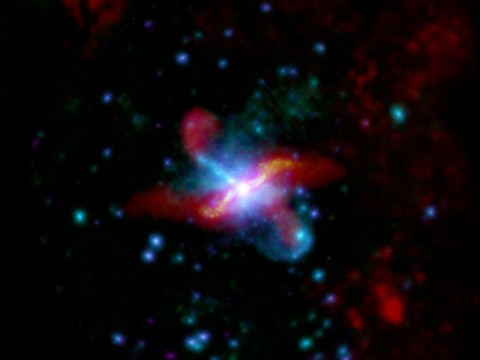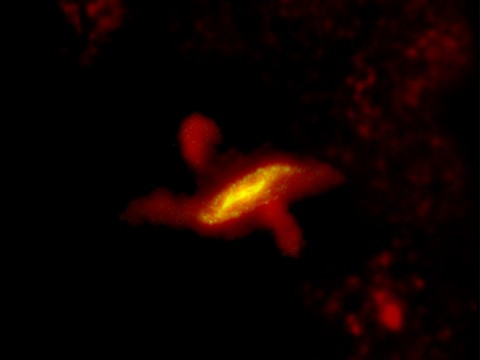Written by Whitney Clavin
NASA’s Jet Propulsion Laboratory
 Pasadena, CA – Infrared and X-ray observations from two space telescopes have been combined to create a unique look at violent events within the giant galaxy Centaurus A. The observations strengthen the view that the galaxy may have been created by the cataclysmic collision of two older galaxies.
Pasadena, CA – Infrared and X-ray observations from two space telescopes have been combined to create a unique look at violent events within the giant galaxy Centaurus A. The observations strengthen the view that the galaxy may have been created by the cataclysmic collision of two older galaxies.
The infrared light was captured by the European Space Agency’s Herschel Space Observatory, a mission with important NASA contributions. The X-ray observations were made by the European Space Agency’s XMM-Newton space telescope.

While previous images taken in visible light hinted at the complex inner structure in Centaurus A, combining the output of two orbiting observatories working at almost opposite ends of the electromagnetic spectrum has revealed the unusual structure in much greater detail.
The galaxy was observed by astronomer Sir John Herschel in 1847 during his survey of the southern skies. Now, more than 160 years later, the observatory bearing his family name has played a unique role in uncovering some of its secrets.
With the Herschel observatory, the giant black scar of obscuring dust crossing the center of Centaurus A all but disappears when viewed at long infrared wavelengths. The images show the flattened inner disk of a spiral galaxy, the shape of which scientists believe is due to a collision with an elliptical galaxy during a past epoch.

The Herschel data also uncover evidence for intense star birth toward the center of the galaxy, along with two jets emanating from the galaxy’s core — one of them 15,000 light-years long. Newly discovered clouds co-aligned with the jets can also be seen in Herschel’s view.
The jets seen by both satellites are evidence of the supermassive black hole –10 million times the mass of our sun — at the center of the galaxy.
This unique collaboration, along with observations from the ground in visible light, has given us a new perspective on the drama in objects like Centaurus A, with a black hole, star birth and the clashing of two distinct galaxies all rolled into one.
Herschel is a European Space Agency cornerstone mission, with science instruments provided by consortia of European institutes and with important participation by NASA. NASA’s Herschel Project Office is based at NASA’s Jet Propulsion Laboratory, Pasadena, CA. JPL contributed mission-enabling technology for two of Herschel’s three science instruments. The NASA Herschel Science Center, part of the Infrared Processing and Analysis Center at the California Institute of Technology in Pasadena, supports the U.S. astronomical community. Caltech manages JPL for NASA.
More information is online at www.herschel.caltech.edu , www.nasa.gov/herschel and www .esa.int/SPECIALS/Herschel .


